Kauhajoki 6 day
“If Man is five, if Man is five
If Man is five, then the Devil is six
Then the Devil is six, then the Devil is six”
In my first 6 day race (EMU at Balatonfured in 2019) there were short periods where the miles came easily, but I spent far too much time finding excuses to stop moving, and needlessly checking the scoreboard. In contrast, at Kauhajoki I spent a lot of the last few days in a blissful state of flow. Keeping shuffling around the 1.5km circuit felt easy. And I had a sense that this was what I was supposed to be doing. A month later I’m struggling to put this feeling into words (in particular ones which don’t make me sound completely batshit insane…)
Thanks to a tent related mishap (more later…) I misplaced my iPod. But surprisingly I was OK with this, as my head provided me with a ‘sound’-track. This was often in the form of fragments of song lyrics, in particular the ones above. But the monkey never went to heaven, and instead I’d segue from the Pixies into Basehunter (“with your pictures hanging on the wall”). I also spent many hours ‘replaying’ my epic, miserable 10 day Monarch’s Way, DNF. Recalling a lousy failure doesn’t sounds like a good motivational tactic, but actually I drew strength from it. This race wasn’t going to last as long, and I was feeling, and doing, much, much better.
The build-up
After the EMU 6 day at Balatonfured in 2019 I was keen to do another 6 day in 2020. Due to the foot injury which caused my Monarch’s Way DNF, my training for Balatonfured was almost all fast walking rather than running. However tendonitis mid-race made walking painful, and I discovered that, despite the lack of training, I could still ‘shuffle’. (My shuffle is what my body does when my head tells it to run after 2+ days of moving. It’s comparable in pace to my fast walk, but I can keep it up almost indefinitely). Even though I wasted a lot of time off the course, I still managed a not-too-shabby 362 miles, and beat my (super secret) pre-race goal of 350 miles. This made my ultimate goal of 400 miles seem doable, if I managed to show up at a race with proper running fitness. In my post race blog, I boldly declared: “Failure due to illness or injury will be acceptable. Failure because I've spent too long sat (or laid) on my arse won’t!”.
In early 2020 I entered the Kauhajoki 6 day that Summer. But in Spring, just as I was about to ramp my training up, it became clear that that wasn’t going to happen. The race was eventually rescheduled for 2022, but covid put another spanner in my works. By Easter 2022 I was exhausted, from two years of pandemic and family stress, and short of proper training. However a short break in Iceland (our first proper, adventurous holiday for 2.5 years) perked me up and I was looking forward to running the 270km Pennine Bridleway Challenge as the start of my build up to the 6 day. A couple of days before that race my throat started feeling scratchy and (after a couple of negative tests) I test positive for covid. Looking on the bright side, at least I didn’t unknowingly start a long race with covid. My visible symptoms were only ‘bad cold’, but the tiredness lingered and, knowing several people with long covid, I was cautious about over doing things. I did a grand total of 37 miles in April, and then 57 in May, with a significant fraction of those miles being walking rather than running.
June was a higher mileage month, 149 in total. However 100 of these were the Long Distance Walkers Association (LDWA) 100. I have history with the LDWA 100. My first 3 100 milers were LDWA 100s. The first 2 were painful 34-35 hour sufferfests. I went out too fast, trashed my feet and/or stomach, and ended up hobbling at 2 mph (and getting overtaken by armies of power-walking old age pensioners). The third (the 2012 Games 100) was ‘do or give up on 100s’. Either I’d get it right, or I’d stick to shorter ultras. Fortunately I got it right. I kept running all the way to the end and moved my way through the field, finishing towards the front. Over the next few years I discovered that multi-day ultras are my ‘thing’, and 100s are a bit short for me! However the 2022 LDWA 100 was on home ground in the Peak District, and it seemed like a good final long, long run. Entering was non-trivial though. I’d missed most of the qualifying events, so had to drive to the Lake District and do a '50 mile anytime challenge’.
With so little training, attempting to run 100 miles was clearly a bad idea. It wasn’t even clear that walking 100 miles was feasible, but attempting it would at least tell me if it was worth going to Kauhajoki. A large fraction of the first 20-ish miles were on the Trans Pennine Trail, the sort of flattish, even terrain which usually suits me. However my plan was to walk every step of this. If, and only if, I felt OK I’d then jog anything easy in the next 75 hilly miles. And ideally I’d shuffle-run the final flat 4 miles to the finish. I stuck to my plan, finishing in ~35 hours, comparable to my first 2 disastrous 100s, but a lot less painful. And I finished early enough in the evening that the OH came and picked me up, so I could sleep in my own bed rather than on the floor of a school gym full of snoring runners and walkers. Even better, there were no after effects; within 48 hours I was walking fine, and no more tired than I was before.
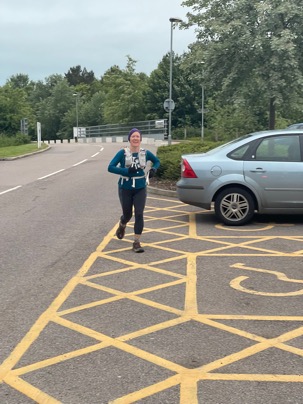
shuffling to the finish of the LDWA100
This gave me some confidence that it was worth attempting the 6 day, but I wasn’t at all sure what sort of milage would be possible. I’d previously formulated a ‘400 mile’ strategy: 18 hours a day of moving at 3.5 mph = 63 miles a day, and five 63 mile days plus an 85 mile first day = 400 miles. However with my lack of fitness, training, and energy, I didn’t expect to be able to manage either the 3.5mph or the 18 hours, so 400 miles was off the table. Quite possibly even a PB (>362 miles) was overambitious. Therefore my goal was simply to execute as well as I could, and avoid wasting time like I did at Balatonfured. None the less I updated my ‘target list’ of placings on the UK all-time women’s 6 day ranking list to include placings in the 2022 world rankings. At Balatonfured once I’d made my 350 mile target, I slowed right down, until someone pointed out that if I put my mind to it I could reach 361, and the top of that year’s UK women’s rankings. So on the off chance that a PB was possible, having some additional targets would be good.
The one plus side of the lack of training was that I would be starting the race injury, and niggle, free. Or so I thought 2 weeks beforehand. During my final (not very long…) run-walk it rained heavily, my waterproof trousers rubbed my ankle which led to a modified gait and knee pain. A week later the calf on my other leg started hurting, and my legs ended up looking like they were being held together with KT tape. These were the sorts of niggles (in particular the knee) that could deteriorate badly and become ‘unrunnable’, or they could clear up completely after a couple of days of running. I ordered several more rolls of KT tape, and hoped for the later.
I also did some last minute gear shopping. A communal sleeping areas was available, however I’m a light sleeper, so sleeping outside in a tent would be better. I’d planned to take the cheap Decathlon tent I’d used for the Gloucester 48hour (my usual fast packing tent is a bit small and fragile). However when I started packing I realised the cheap tent would take up too much space in my holdall. So I panic bought another tent, the soloist XL from Alpkit. It’s great, and I should have bought this rather than the Decathlon tent last year (to rub salt into the wounds of my bank balance, when I opened my email to check for the order confirmation, I discovered an earlier email with a discount code for that very tent…)
Getting to Kauhajoki was a bit of a faff. I’d decided to fly from Heathrow, rather than Manchester, as the more convenient flight times would offset the longer journey to the airport. However that weekend there were no direct trains to London due to engineering works, so I ended up getting the coach to London. And carrying my over sized holdall from the coach station to the tube station I hurt my shoulder. Thankfully a ‘not completely functional’ shoulder isn’t a big issue for running, but it did contribute to me breaking a glass jug during the race.
British airports in Summer 2022 are somewhat chaotic and I’d been paranoid that I’d miss my flight and/or my baggage would get lost. However I walked straight up to Finnair baggage drop and the security queues weren’t too bad, so I had time for a pre-flight burger, chips and pint. On arrival in Helsinki the world’s friendliest border guard was very amused by the idea of a six day race and taught me how to pronounce Kauhajoki correctly. Another last minute panic buy (an Apple airtag) proved useful at baggage reclaim when there was a long delay. While other people stressed, I could see my bag was at least moving slowly from the plane towards the baggage hall.
I arrived at my hotel fairly late, and on giving my name the guy on check-in responded with a worried look and “oh dear”. He reassured me that they did have my reservation, but the only rooms left were on floor 2, next to their late night disco. I was aware from reading reviews that Saturday night was likely to be a bit ‘lively’ (one review compared the hotel to the Stockholm-Helsinki overnight ferries), I booked it anyway as it was close to Tikkurila station (where the airport and long distance trains both stop). I told him (with accompanying hand gestures) that I knew about the disco, and had brought ear plugs with me. I obviously overdid my ‘no worries it’s OK’ routine, as he then told me that tickets for the disco were 10 euros. Thankfully when I got to my room I could barely hear the music even before I put the ear plugs in (I’ve spent more than one ‘night before an ultra’ in a room above a pub, with music so loud the floor vibrates).
Next morning I had a late breakfast (in the nightclub), before getting the train a couple of hours North to Seinajoki. There I had an hour and a bit to wait in the (a bit too hot for running) Sun, with lots of metalheads on the way home from a festival, before getting a rather small bus to Kauhajoki. It turned out it was possibly to sleep on the floor at the event centre before the race. However I was glad I’d booked a guest house for one last comfortable night’s sleep in a room on my own. Somewhat extravagantly I actually booked 2 nights, so I could take my time getting up and moving my kit before the race start at 6pm.
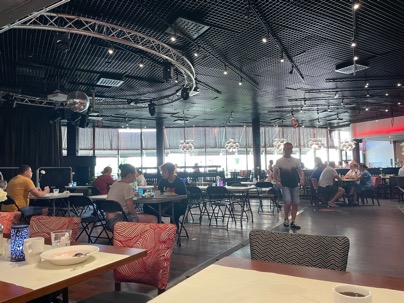
Breakfast in the hotel disco…
The moving my kit bit didn’t go entirely smoothly. I’d bought some large bottles of Mountain Dew (my multi-day rocket fuel) and put them into the side pockets on my rucksack. As I attempted to manoeuvre my hold-all out the front door, one of the bottles fell out, bounced down the steps, knocked over a lantern and punctured, spraying sticky liquid everywhere. Fortunately the guest house owner found this rather funny (or at least did a very convincing job of pretending to). I got my kit moved and set up with sufficient time to spare to go to the supermarket again and buy another bottle of Mountain Dew. Another spanner in the works was a slightly upset stomach. In retrospect this was just due to my period (which has an amazing ability to show up late or early when I’m doing a race), however I took a precautionary immodium, which I would come to regret over the next few days…

Tent and mountain dew
The beginning (days 1 and 2)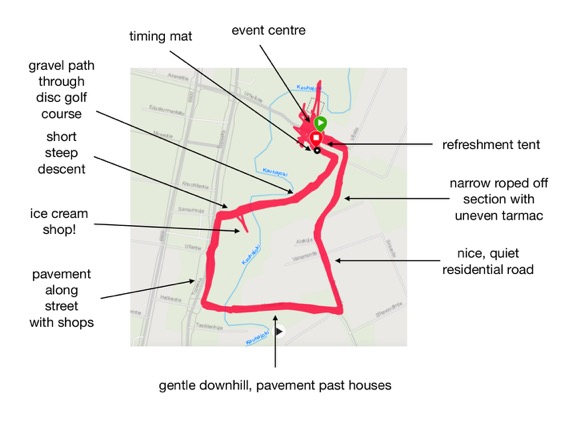
the 1.5km course
With fixed time races, what happened when is always fuzzy. A lot of what follows is reconstructed from text messages and tweets.
Even when I’m fit, I start slower than almost everybody else, so it was no surprise to find myself in ‘last but one’ position in the early stages, with just a walker behind me. However unlike most races, no-one started stupidly fast. Not far in front of me was a bloke with a Spartathlon tattoo on his calf, and it was quite some time before anyone lapped me. 3 hours in my legs hurt but, given the issues I’d started with, this wasn’t surprising. The rest of my body wasn’t particularly happy either; my stomach felt bloated and the comfy yoga shorts I was wearing (which had worked well for 48 hours last Summer) felt uncomfortably tight.
I initially walked one 1.5km loop every hour, however the lack of training meant this soon felt like too much, and I steadily reduced the ratio of run-to-walk laps. And even on the running laps I soon resorted to walking the tight bends, uphills and anything uneven. The gravel part of the loop (through a disk golf course!) had a short, sharp-ish climb, surrounded by sections of flat. Throughout the 6 days I did a fairly good job of starting running again at the top of the climb, but I struggled to run the preceding flat. I don’t know if the gravel was deeper, or whether I was just being lazy, but it felt like too much effort and I quickly gave up on trying to run it.
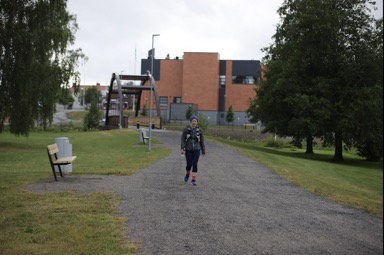
walking (when I really should have been running)
My general sleep plan was to have one 3-3.5 hour ‘big sleep’ a day, and time it so that I started moving around dawn (to try and fool my body into thinking that I’d had a full night’s sleep). I never sleep well on the first night of a multi-day, and on a point-to-point race I’ll usually run through the first night (with a short power nap at dawn if I’m sleepy). However in fixed time races stopping for a shorter (1.5-2 hour) sleep on the first night seems to work better, so on the first night I stopped to sleep at about 3am. While the Sun set for 4 or 5 hours, it never really got dark and the twilight hours were actually very pleasant for running (no head torch needed).
During the morning there was a heavy thunderstorm and many of the 6 day runners stopped and sheltered. However the storm was never directly overhead, and I didn’t want to lose a lot of time (and miles) early on, so I kept going. And if I stopped I’d have had to either wait until the rain stopped before starting again, keep my wet clothes and shoes on, or get 2 pairs of shoes wet. So keeping going seemed like the best option.In parallel with the 6 day there were various other events: 72, 48 and 24 hours, plus daily marathons. Over the days I’d come to look forward to the daily marathon starting. It marked the passing of time, and the runners would often make encouraging comments as they overtook. However on the first day the course suddenly felt very crowded.
I passed through 100km during the morning. I would have been unaware of this if it weren’t for having my photo taken. While I was wearing a Garmin, I deliberately wasn’t paying attention to total distance. I was focussing on keeping moving as well as I could, keeping one eye on my lap times, and setting target numbers of laps for each time block. I was also completely unaware of the fact I was in 1st place at this point. There were several runners moving faster than me, but they must have been stopping for longer than me. The OH texted me that I was in 1st place however I assumed he meant first woman (and was even surprised by this). I only discovered that I was in fact 1st overall when I stopped at the end of day 1 to check and record my milage for the day. It was particularly surprising as I’d only done 81 miles, which is not at all a big first day, even by my standards. At Balatonfured I’d done 79 miles on day 1 walking, with one run lap an hour. So I was a little disappointed that running much more had only netted 2 more miles. But given the lack of training this possibly wasn’t surprising.
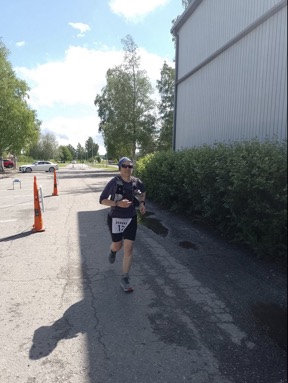
passing through 100km
Day 2 started fine and I kept moving well through the night and into the morning. Various helpers made sure that, unlike at 100km, I stopped and had my photo taken properly at 200km with a picture frame. While we were trying to work out how many more laps I had to do to reach 200km, I declared that I wasn’t particularly bothered by 200km. However over the next few days the 100km multiples became a focus. I typically reached them around midday, so they broke the time between breakfast and lunch into two nicely. They also coincided with the ice cream shop next to the course opening, and I got into the habit of treating myself to a short break with an ice cream (I initially tried mint choc chip, but soon settled on mango and chocolate).
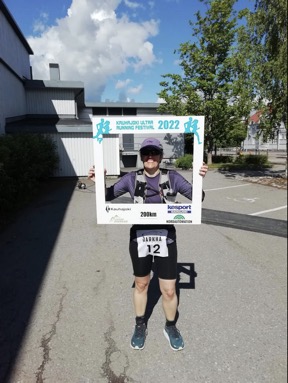
200km

ice cream (photo from later in the week)

the ice cream shop
(in front of/next to the Rock Pub…)
One of the other 6 day runners, Jean-Louis Vidal, has (literally) written the book on multi-day running. He was constantly positive, and keen to offer advice and encouragement to other runners. He told me that based on how I was moving I could reach 400 miles. I replied that maybe in another race, but not here. Given my first day total, I thought 390 would be the most I could do, even if the rest of the race went as well as possible.
The weather was surprisingly humid, and there was another heavy storm. When I went back to my tent to get my poncho I discovered that the guttering of the event building was overflowing and water was running underneath my tent. I spent the next half an hour moving all my stuff indoors. The rain in fact eased off not long afterwards, and a better solution would have been to simply move my tent. However I was worried that all my clothes would get soaked, which would ruin my race. When the rain stopped I had a late lunch break, changed into dry clothes and let my feet dry off. I often have difficulties eating on days 2 and 3 of multi-day, but my stomach was more bloated and uncomfortable than usual. At this point I couldn’t manage to get more than a few mouthfuls of food down, which left me short of energy and irritable. I was very envious of the bloke with a camper van and someone crewing for him (no tent evacuation for him…)
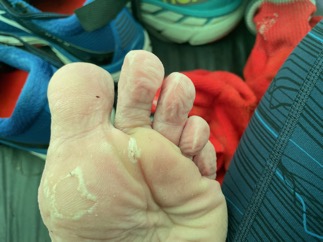
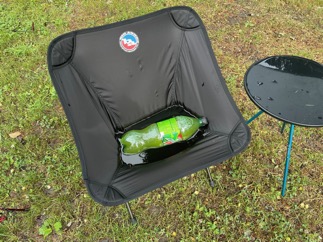
wet foot and wet chair
Sleeping in the communal sleeping area didn’t go entirely smoothly. While trying to work out how to set my phone alarm to vibrate, so I didn’t wake everyone else up at 3.45am too, I in fact set it off, not once but twice. Having disturbed everyone else’s sleep, I then didn’t manage to get much myself. It was far too hot, even outside my sleeping bag in my underwear. And without the walls of my tent to keep me in place I kept rolling off my mat. But at least none of the other runners killed me in my sleep in revenge for disturbing them.
Things started improving on the eating front at breakfast. I don’t usually like porridge (too milky). However the porridge here was great, in particular with the fruit compote or natural yogurt that was provided. Watching Antti (the race organiser) head off in his car at ~6.30am, and then return shortly after with the big pot of porridge became one of my daily landmarks.
After the awful night’s sleep, I decided my best option was to move my tent away from anywhere water would likely flow. So I spent/wasted another 20min moving all my stuff back outside again. And had another ‘numpty’ moment when I nearly knocked a runner who was getting food over with my holdall.
As well as eating and sleeping, I also struggle to attach timing chips and lace my shoes so that they don’t irritate me and/or my ankle: too tight and they cause tendonitis, too loose and things move around, and cause tendonitis. I’d spent a lot of time on day 1 faffing around, and thought I’d eventually got the laces and chip positioning right. But late on day 2 I suddenly noticed that the chip had slipped down and irritated my achilles tendon. It was visibly inflamed and, even with tape, the heel cups on my Hokas irritated it. Cutting bits out of running shoes is not unusual in multi-days, but I didn’t want to do something a major as cutting the backs out this early. Fortunately I had another pair of running shoes with me. I’d been planning to start in them, and then switch into Hokas once my legs/feet got sore, but at the last minute I’d decided to start in the Hokas. The spare shoes would now save the day, along with the slightly unusual timing ‘mats’. Usually timing mats are horizontal on the ground, so the chips have to be on your ankles or they don’t register. However these were vertical, and I’d spotted one runner wearing her chip on her wrist, so I moved mine there (my wrist, not hers) too.
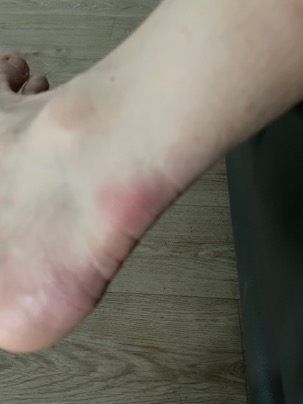
sore ankle
At the end of day 2 I’d managed another 62 miles (for a total of 143) and was still, despite the issues, in the lead, albeit with 3 or 4 people close behind. I was also ~5 miles up on Balatonfured. If, big if, I could manage the achilles issue I could hopefully start putting miles into past me, as I only managed 53 miles on days 3, 4 and 5 in Balatonfured.
The middle (days 3 and 4)
This is the point were things started going better, but exactly what happened when gets very fuzzy. Around day 2/3 the niggling issues with my legs cleared up, and I also shifted from alternating running and walking laps to shuffling every lap (but still walking anything uphill or uneven).
Post breakfast I felt sleepy, and went back to my tent for a quick power nap. However, despite it being 7.30am in the morning, some noisy work involving power tools started. It turned out that the banks of the river that ran through the course were being cut back, and this continued for the next few days. At the time not being able to power-nap in my tent was frustrating, but it was at least a disincentive to taking unnecessary breaks (on the few occasions when I really needed a 10 min sleep I did it in the communal sleeping area).
A journalist from a Finnish ultra-running magazine had been taking photos around the course over the last day or so. When I stopped at the refreshment tent to drink some Mountain Dew he introduced himself and told me that it was impressive that I’d finished the Spine race, which was good for my ego. The Mountain Dew went down well, so I had a 2nd large slug, and answered the question of why I wasn’t wearing gaiters for the gravel part of the course (the risk to them causing tendonitis outweighed the annoyance of occasionally having to empty gravel out of my shoes).
Over the next few hours my stomach problems resolved. My bowels started moving again after the ill-advised immodium, and I suddenly became extremely hungry. I passed the time planning what I’d eat from the refreshment table, not just on that lap, but the next one, and the one after that.
It rained again, for hours, sometimes extremely hard. My poncho was clinging to my legs and annoying me, and not doing a particularly good job of keeping me dry. I put on my heaviest duty running raincoat, and the rain still soaked through it, so I switched back to the poncho. I kept it on for the 300km photo, even though the rain had eased off, because I wanted at least one of the photos to show signs of the rain. After the photo I had an unplanned hour long break to catch up on some of the sleep I’d missed and dry off my feet, to hopefully avoid blisters.
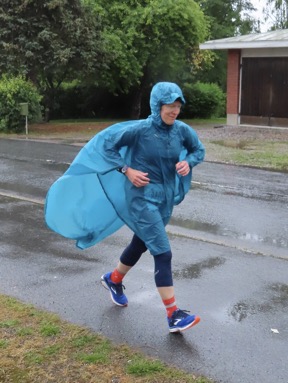
poncho shuffling
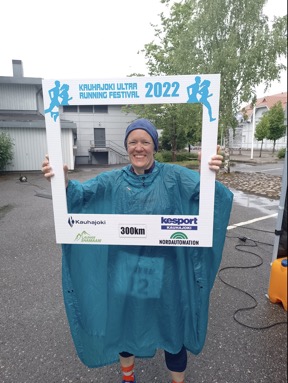
300km
The extra break led to a slightly shorter day, 60 miles, for a total of 203 miles. But the good news was I was feeling better than I did at the end of day 2, and had put another 7 miles into past me. Petri, the man with the Spartathlon tattoo, had overtaken me. I’d discovered (from checking the DUV ultra marathon statistics web-site while eating) that he had a lot of multi-day running experience and a 700km 6 day PB, so this wasn’t a surprise. There were several other runners not far behind and running well, so I was expecting to loose more places. In races up to ~2 days I tend to just move through the field, but in multi-days I get passed by people who run faster but rest more. Normally there are far more people who crash and burn, so I still move up the field overall. However the sensible pacing of the Finns meant there was no ‘road-kill’ in front of me to run down.
The weather was much ‘better’ on day 4. However hot, Sunny weather posed some different challenges. I did a good job of putting sun-cream on my arms and legs and preventing them burning. However I didn’t do as well with my face and hands (I guess the sun-cream washed off every time I splashed my face with water after going to the toilet). I licked my lips, they felt nice and smooth and I thought (too soon) ‘at least I haven’t burnt my lips like I’ve done before’. Not long after they started hurting, and despite repeated application of lip balm they kept getting worse, and eating became painful.

sunny 400km
At one point Pasi, who was in 3rd place asked me how I was feeling. I said something about good and bad patches. He told me about a conversation he’d had with Wolfgang Schwerk (number 3 on the all time 6 day rankings) about how he always felt bad during 6 days. We concluded that that was probably necessary if you want to run really big distances. This triggered several hours of pondering the best mental approach to 6 days for me (given that I’m exploring my personal capabilities for fun, rather than trying to set world records). ‘I don’t chase dreams, I hunt goals’ might be a good approach for training and shorter (<24 hour) races, but for 6 days ‘slowly slowly catchy miles’ probably works better.
Day 4 was another 62 miles, for a total of 265, and 20 miles up on past me.
The end (days 5 and 6)
This is where things got ‘flowy’, and when things were going well hours passed effortlessly.
Today was Friday, and in the evening Kauhajoki got lively in the way that small towns do; public drinking and young people driving around in vehicles that make lots of noise. There were a couple of security guards patrolling the course, but actually it felt safer than running through a British city on a weekend evening. None the less I decided to move my tent (again…) so that it was in view of the refreshment tent.
The sunburnt lips and my habit of sleeping with my mouth open combined to cause sleeping problems. I kept waking up in pain, with my teeth stuck to my bottom lip. I even had a dream in which I set my cosmology students an online poll about whether I should prioritise unsticking my teeth from my lips, or rolling onto my back to take the pressure off my ankle tendons. (I decided for myself that it was most efficient to do the former first, smear my lips in sudocrem, and then do the later.)
This was the hardest morning for getting moving again. My legs and feet were initially extremely painful. After half a lap of walking I forced myself to shuffle, and quickly the pain disappeared. During the morning I got some thigh chafing (I think from not being careful enough about rearranging my tights and pants after a toilet stop). It was nowhere near as bad as my Monarch’s Way or Vol State chafing (no blood, no scabs, and no thigh taping), but would need managing carefully for the rest of the race. I initially changed into some baggy shorts, to give it some air. But they had too much loose fabric, and rubbed my legs elsewhere. I ate my 500km celebratory ice cream in my tent so that I could air my crotch, before digging the most comfy shorts out of my dirty washing bag. Several other runners were wearing different, colour co-ordinated, outfits everyday, while I resorted to wearing shorts that could have probably stood up (and even ran) on their own.
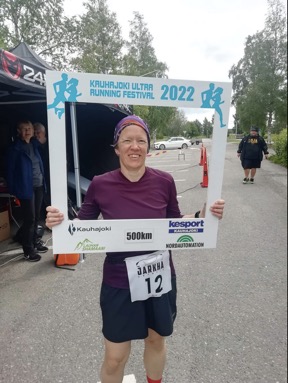
suffering from chafing at 500km
Despite the chafing I’d been moving well with minimal stoppage time, and I became thinking that day 5 would be a higher milage day than the previous 3. However the weather then turned stormy again. Ominous dark clouds formed in the distance. Petri (the leading runner) pulled alongside me for a chat. He introduced himself and apologised for not doing so sooner, and we shook hands. (I’m very bad at starting conversations with people I don’t know, and had joked with friends beforehand that ‘Knowing me, and knowing the Finns, we’ll probably just about be on ‘hello’ terms by day 4.’). He told me that there were several bands of heavy rain forecast to pass over in the next few hours (the weather web-site I was using had told me that heavy rain was forecast, but not that much detail).
After a few hours of miserable weather I started feeling very sleepy, so I decided to have an unplanned 30 min sleep break (and compensate later by cutting back on my main sleep). I’d been saving listening to music for when I’d really benefit from a pick-me-up. However now I needed it I couldn’t find my iPod. My ankle was also threatening to cause problems. Taping, changing shoes and sticking to a single loose pair of socks had kept my timing chip-induced issue from day 2 at no worse than tender. However now I was getting sudden sharp sensations in my ankle, as if it was being poked by stones. Day 5 ended up being a slightly disappointing 61 miles, for a total of 325. However I was now 28 miles up on past me, and even a modest final day (38 miles) would bag me a PB.
After dinner I spent half an hour working out how to make my ankle as comfortable as possible: tape in different places, a very thin pair of socks carefully positioned so as not to put pressure on any tendons and extremely loosely laced shoes. If I’d tried running properly my shoes would probably have fallen off, but it turned out that this set-up was extremely comfortable for shuffling. The 24h race meant new, fast moving runners on the course. I tried to stay out of their way, but my coordination was woeful, and I nearly knocked over the leading runner.
Apart from waking up regularly to re-balm my lips, I had my best night’s sleep of the race. In particular the rainy weather meant there wasn’t much ‘street’ noise, despite it being a Saturday night. My alarm went at 3.45am and it was surprisingly easy to get myself up moving. After only a couple of 100 metres of walking I got straight back to shuffling.
My body was still moving well but eating the fuel required to keep it going was a problem. I was ravenously hungry but anything touching my lips was agony. Lemon water had been added to the drinks on offer on the refreshment tent. It was wonderfully refreshing, but even tipping it straight down my throat chased by water, was painful. At breakfast I shovelled down a massive bowl of porridge and yogurt, while a 24 hour runner suffering from nausea watched open-mouthed.
The morning passed well, helped by lots of encouraging comments from other runners. In more than one conversation I struggled to explain quite how slow I am over shorter distances (‘no I can’t run 200 (300km) in 24 (48) hours’, ‘no I haven’t run Spartathlon; I’d get timed out before 50 miles’).
I went through my 582km PB without even noticing. Come 600km I was keen to have the celebratory photo taken, but ironically this was the first time the frame, and a person with a camera, weren’t ready and waiting for me. Despite my list of target distances, I then had a motivational low patch. Not as bad as at Balatonfured, where I sat on my arse for 45 min after reaching 350 miles, but I struggled to get back shuffling after my ice cream break and walked a couple of laps.

600km
The vegetarian food during the race was really good, but initially at lunch time there appeared to be no vegetarian food, apart from salad & bread. I was ravenous and low on energy, and started panicking about how I was going to manage to get enough calories in. However it turned out that the vegetarian food was there but just hadn’t been got out of the box it was delivered in.
Post lunch I focussed on keeping moving, and wracking up as many miles as possible in the remaining 3.5 hours. Given my ankle issue I didn’t push hard until the last 10 minutes or so. For the last half hour I’d calculated that I’d finish the race close to the start-finish line, and not have far to walk back. But I actually did and extra half lap and ended up on the opposite side of the circuit. This meant an extra half mile of distance, but (after a brief sit on the pavement) a painful walk back. Suddenly everything hurt and (to the alarm of the 24 hour runner who’d finished nearby and his supporter) I grunted and groaned out loud. Once I got moving again the pain wasn’t too bad, however walking the wrong way around the circuit felt really strange.
Day 6 was 68 miles, for a total of 393.1 miles (632.7km) and a 30 mile PB. In the end I held on to 2nd place overall (and 1st woman) fairly comfortably. Petri, the winner, was 10 miles ahead of me, however he was running very easily, and I suspect that if I’d tried to close the gap he could have ramped things up and run further. I felt surprising perky post race and, instead of forcing dinner past my sore lips, started packing up my kit. After a break for the prize giving ceremony (where I got given what google later revealed was a very fancy Finnish sauna towel) I managed to get myself and all my kit back to the guest house without breaking anything or anyone.
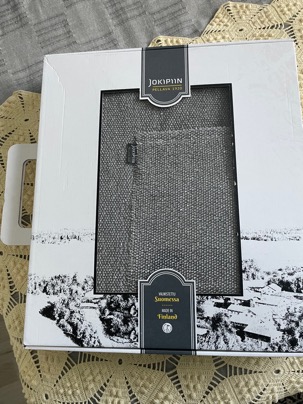
fancy Finnish sauna towel
In light of the ‘leaving my iPad on the plane and in sleep-deprived confusion panicking that it had been stolen’ incident on the way home from Balatonfured, I’d decided to not rush the journey home. After a lie-in, I had a big breakfast and bought some (naff but cheap and, most importantly, clean) shorts for the journey home. I caught a much bigger bus back to Seinajoki with various other runners, and then the train back to Helsinki (I was very glad that I’d booked in advance, and for not many euros had been able to buy the seat next to me). I stayed at a fancy (but not too expensive) airport hotel and had a nice (but expensive) meal and beer at the airport before getting an early flight back to Heathrow the next day.
Apart from my lips, I recovered from the race pretty quickly. My achilles tendon didn’t like the long queues for security and passport control, and by the time I got home I was limping, however it got better quickly. My lips were the bigger issue, for several days I could only eat (enormous quantities of) mashed potato.
Post race reflections
I’m really happy and surprised that I managed to get so close to 400 miles, off the back of such limited training and fitness. If the DUV ultra statistics web-page is correct, then if I was Finnish I would now be the national women’s 6 day record holder, which feels really surreal! The UK women’s ranking are stacked though. At the time I thought my 582km at Balatonfured put me in the top 10, but some historical results have since been added to DUV. With 632.7km, I’m now showing as 11th, however I suspect that 2 of the women above me are in fact the same person.
It would be easy to obsess about what I could have done to get an extra 7 miles (not faff around with my tent and an hour’s less sleep are the obvious things). But I haven’t really fallen into that trap. Partly because I went into the race with no expectation of getting anywhere near 400 miles, and partly because overall I’m really happy with how I executed. On days 2-6 I didn’t quite meet my '18 hours a day moving’ plan, but I was only 30-45 minutes a day off, and the extra breaks while maybe not all completely necessary were at least justifiable. I didn’t waste hours sitting/lying on my arse this time.
400 miles is clearly within reach if I can show up at a 6 day fit and uninjured. The unknown question is how far beyond that I’m capable of going. With better training I could definitely run and walk faster, and rack up more miles on days 1 and 2, and hopefully my shuffle might be a bit faster too. Given that I felt pretty alert on and after day 6, I could probably cut back on sleep on the last night. However I’m wary of cutting back on the other days. Sleep deprivation is like training; slightly over doing it is much worse than slightly under doing it.
I’ve played around with calculating X + 4Y + Z for various combinations of X, Y and Z (daily milage for days 1, 2-5 and 6 respectively) and 420 miles seems possible. And there’s a big round metric number, the benchmark of a ‘good’ 6 day performance for women, lurking not too far beyond that. It seems so over-ambitious for me that I’m reluctant to put it into words. But maybe, if everything (training, execution and external factors) went really, really well I might be able to get close to 700km (435 miles). Although the lesson that I’ve learnt over the past few years, and in particular from this race, is to focus on execution rather than targets.
As well as better training and fitness, a course better suited to my strengths would help rack up the miles. I’d previously dismissed running for 6 days on an indoor track as utterly insane, but I’m currently leaning towards 6 days at the Dome (assuming it takes place again). It’d be mentally tough, but otherwise probably has the best running conditions for me. My biggest strength is my shuffle, and it works best on smooth tarmac or a track. Being indoors with a cool temperature would also avoid or alleviate the issues (chafing, blisters, sore lips) caused, or exacerbated, by rain and heat. I’m not keen on communal sleeping areas, but learning how to sleep in headphones might help with that.
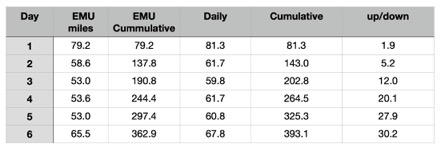
milage
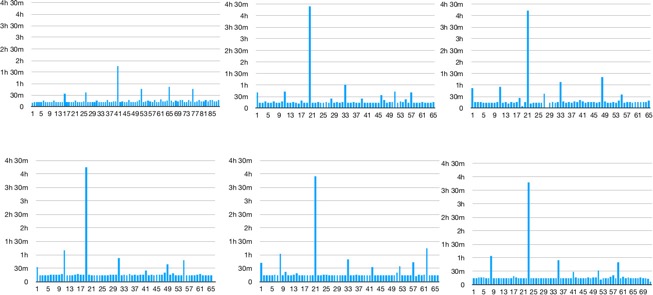
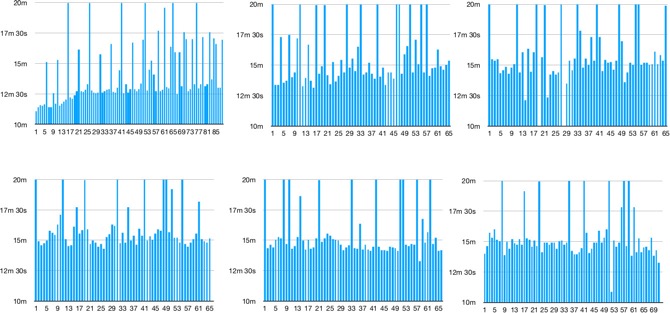
lap times
top row left to right: days 1-3, bottom row: days 4-6
top figure: y-axis from 0 to 4.5hours
bottom figure: y-axis from 10 to 20min
(a handful of times I forgot to hit the lap button until part way round the next lap, leading to a 'too long' lap followed by a 'too short' lap)
Period postscript
I’ve left this to the end, to make it easier for the uninterested to skip. I’ve found it really useful when other women have shared their experiences of dealing with periods during multi-days, so here we go:
Up until ~3 years ago I was taking the contraceptive pill, and avoided periods during races by not having a break between packets. However my GP convinced me that with the menopause approaching I should probably stop taking the pill. Since stopping, my periods have settled into a fairly regular 3.5 week cycle, and are still fairly light. However multi-day races really mess with them. All but one of the 7 or 8 multi-day races I’ve done post-pill have coincided with my period. Typically it starts a few days early or late, during my taper or the race itself. A couple of times within half a day of a race finishing it’s started, really early (> 2 weeks) and much more suddenly and heavily than usual. (I’m guessing this is my body deciding that immediately after a multi-day race is a bad time for getting pregnant, but given that I’m nearly 50 there’s no good time for getting pregnant!). At Kauhajoki it did both! It started, late, the day before the race, and lasted its usual 3 days. And then another one started during the night after the race.